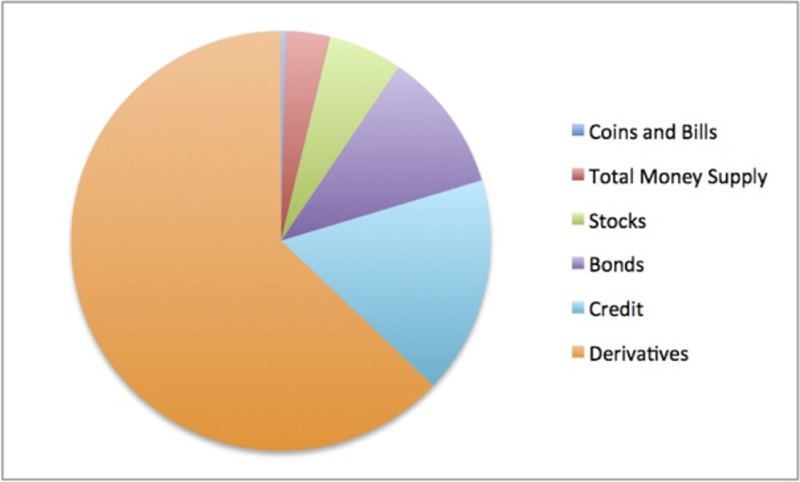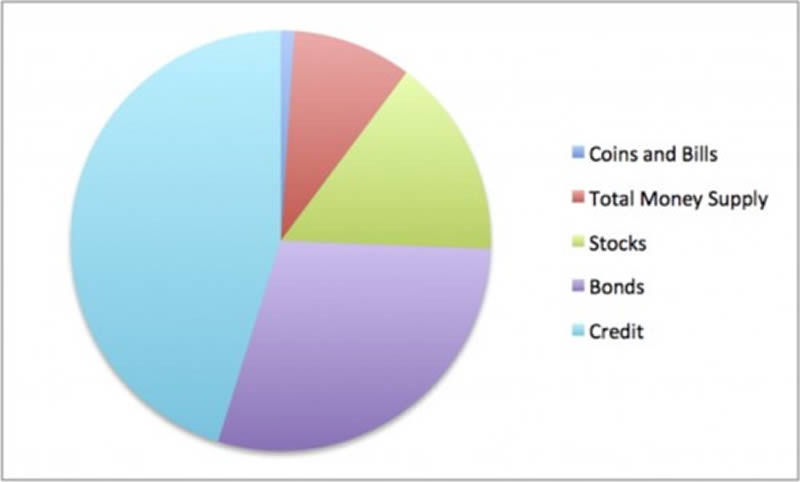The War on Cash is About to Go into Hyperdrive
Interest-Rates / War on Cash Feb 11, 2016 - 05:28 PM GMTBy: Graham_Summers
 The global Central Banks have declared War on Cash.
The global Central Banks have declared War on Cash.
Historically, one of the safest things to do when the markets begin to collapse is to move a significant portion of your holdings to cash. As the old adage says, during times of deflation, “cash is king.”
The notion here is that cash is a safe haven. And while earning 1-2% in interest doesn’t do much in terms of growing your wealth, it sure beats losing 20%+ by holding on to stocks or bonds during their respective bear markets
However, in today’s world of fiat-based Central Planning, cash represents a REAL problem for the Central Banks.
The reason for this concerns the actual structure of the financial system. As I’ve outlined previously, that structure is as follows:
- The total currency (actual cash in the form of bills and coins) in the US financial system is a little over $1.36 trillion.
- When you include digital money sitting in short-term accounts and long-term accounts then you’re talking about roughly $10 trillion in “money” in the financial system.
- In contrast, the money in the US stock market (equity shares in publicly traded companies) is over $20 trillion in size.
- The US bond market (money that has been lent to corporations, municipal Governments, State Governments, and the Federal Government) is almost twice this at $38 trillion.
- Total Credit Market Instruments (mortgages, collateralized debt obligations, junk bonds, commercial paper and other digitally-based “money” that is based on debt) is even larger $58.7 trillion.
- Unregulated over the counter derivatives traded between the big banks and corporations is north of $220 trillion.
When looking over these data points, the first thing that jumps out at the viewer is that the vast bulk of “money” in the system is in the form of digital loans or credit (non-physical debt).
Put another way, actual physical money or cash (as in bills or coins you can hold in your hand) comprises less than 1% of the “money” in the financial system.
Here is the financial system in picture form. I’m not including hard assets such as gold, real estate, or the like. We’re only talking about relatively liquid financial assets items that can be sold (turned into cash) quickly.

Of course, Wall Street will argue that the derivatives market is notional in value (meaning very little of this is actually “at risk”). However, even if we remove derivatives from the mix, the system is still very clearly based on credit, with only a small sliver of actual physical cash outstanding:

Put simply, the vast majority of wealth in the US is in fact digital wealth that moves from bank to bank without ever being converted into actual physical cash.
As far as the Central Banks are concerned, this is a good thing because if investors/depositors were ever to try and convert even a small portion of this “wealth” into actual physical bills, the system would implode (there simply is not enough actual cash).
Remember, the current financial system is based on debt. The benchmark for “risk free” money in this system is not actual cash but US Treasuries.
In this scenario, when the 2008 Crisis hit, one of the biggest problems for the Central Banks was to stop investors from fleeing digital wealth for the comfort of physical cash. Indeed, the actual “thing” that almost caused the financial system to collapse was when depositors attempted to pull $500 billion out of money market funds.
A money market fund takes investors’ cash and plunks it into short-term highly liquid debt and credit securities. These funds are meant to offer investors a return on their cash, while being extremely liquid (meaning investors can pull their money at any time).
This works great in theory… but when $500 billion in money was being pulled (roughly 24% of the entire market) in the span of four weeks, the truth of the financial system was quickly laid bare: that digital money is not in fact safe.
To use a metaphor, when the money market fund and commercial paper markets collapsed, the oil that kept the financial system working dried up. Almost immediately, the gears of the system began to grind to a halt.
When all of this happened, the global Central Banks realized that their worst nightmare could in fact become a reality: that if a significant percentage of investors/ depositors ever tried to convert their “wealth” into cash (particularly physical cash) the whole system would implode.
As a result of this, virtually every monetary action taken by the Fed since this time has been devoted to forcing investors away from cash and into risk assets. The most obvious move was to cut interest rates to 0.25%, rendering the return on cash to almost nothing.
However, in their own ways, the various QE programs and Operation Twist have all had similar aims: to force investors away from cash, particularly physical cash.
After all, if cash returns next to nothing, anyone who doesn’t want to lose their purchasing power is forced to seek higher yields in bonds or stocks.
The Fed’s economic models predicted that by doing this, the US economy would come roaring back. The only problem is that it hasn’t. In fact, by most metrics, the US economy has flat-lined for several years now, despite the Fed having held ZIRP for 5-6 years and engaged in three rounds of QE.
Let me put this very bluntly. The Fed and other Central Banks literally took the nuclear option in dealing with the 2008 bust. They have done everything they can to trash cash and force investors/ depositors into risk assets. But these polices have failed to generate growth.
Rather than admit they are completely wrong, Central Banks are reverting to more and more extreme measures to destroy cash and force investors to move into risk against their will.
Over 20% of global GDP is currently sporting NEGATIVE yields on their bonds.
This is just the start of a much larger strategy of declaring War on Cash.
If you’re an investor who wants to increase your wealth dramatically, then you NEED to take out a trial subscription to our paid premium investment newsletter Private Wealth Advisory.
Private Wealth Advisoryis a WEEKLY investment newsletter with an incredible track record.
To whit, we just closed out two new double digit winners yesterday, bringing us to 40 straight winning trades over the last 12 months.
That correct, during the last year, we’ve not closed a SINGLE LOSER.
And if you go back further, 46 of our last 47 trades have made money.
In fact, I’m so confident in my ability to pick winning investments that I’ll give you 30 days to try out Private Wealth Advisory for just 98 CENTS.
During that time, you’ll receive over 50 pages of content… along with investment ideas that will help make you money… ideas you won’t hear about anywhere else.
If you have not seen significant returns from Private Wealth Advisory during those 30 day, just drop us a line and we’ll cancel your subscription with no additional charges.
All the reports you download are yours to keep, free of charge.
To take out a $0.98, 30-day trial subscription to Private Wealth Advisory…
Best Regards
Graham Summers
Phoenix Capital Research
http://www.phoenixcapitalmarketing.com
Graham also writes Private Wealth Advisory, a monthly investment advisory focusing on the most lucrative investment opportunities the financial markets have to offer. Graham understands the big picture from both a macro-economic and capital in/outflow perspective. He translates his understanding into finding trends and undervalued investment opportunities months before the markets catch on: the Private Wealth Advisory portfolio has outperformed the S&P 500 three of the last five years, including a 7% return in 2008 vs. a 37% loss for the S&P 500.
Previously, Graham worked as a Senior Financial Analyst covering global markets for several investment firms in the Mid-Atlantic region. He’s lived and performed research in Europe, Asia, the Middle East, and the United States.
© 2016 Copyright Graham Summers - All Rights Reserved Disclaimer: The above is a matter of opinion provided for general information purposes only and is not intended as investment advice. Information and analysis above are derived from sources and utilising methods believed to be reliable, but we cannot accept responsibility for any losses you may incur as a result of this analysis. Individuals should consult with their personal financial advisors.
Graham Summers Archive |
© 2005-2022 http://www.MarketOracle.co.uk - The Market Oracle is a FREE Daily Financial Markets Analysis & Forecasting online publication.



